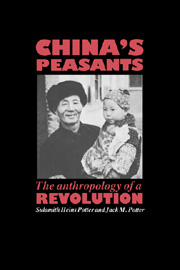Book contents
- Frontmatter
- Contents
- List of illustrations
- List of tables
- Preface
- Notes on the text
- Map 1 China
- 1 The old “feudal” order: Zengbu before Liberation
- 2 Establishing the new order
- 3 The ordeal of collectivization
- 4 The Cultural Revolution
- 5 Maoist society: the production team
- 6 Maoist society: the brigade
- 7 Maoist society: the commune
- 8 Impatient aspirations: transition to the post-Mao period
- 9 The cultural construction of emotion in rural Chinese social life
- 10 Marriage, household, and family form
- 11 Chinese birth planning: a cultural account
- 12 Lineage and collective: structure and praxis
- 13 Party organization
- 14 The party ethic: a devotion born of distress and enthusiasm
- 15 A caste-like system of social stratification: the position of peasants in modern China's social order
- 16 The Chinese peasants and the world capitalist system
- 17 The crystallization of post-Mao society: Zengbu in 1985
- References
- Index
1 - The old “feudal” order: Zengbu before Liberation
Published online by Cambridge University Press: 02 December 2009
- Frontmatter
- Contents
- List of illustrations
- List of tables
- Preface
- Notes on the text
- Map 1 China
- 1 The old “feudal” order: Zengbu before Liberation
- 2 Establishing the new order
- 3 The ordeal of collectivization
- 4 The Cultural Revolution
- 5 Maoist society: the production team
- 6 Maoist society: the brigade
- 7 Maoist society: the commune
- 8 Impatient aspirations: transition to the post-Mao period
- 9 The cultural construction of emotion in rural Chinese social life
- 10 Marriage, household, and family form
- 11 Chinese birth planning: a cultural account
- 12 Lineage and collective: structure and praxis
- 13 Party organization
- 14 The party ethic: a devotion born of distress and enthusiasm
- 15 A caste-like system of social stratification: the position of peasants in modern China's social order
- 16 The Chinese peasants and the world capitalist system
- 17 The crystallization of post-Mao society: Zengbu in 1985
- References
- Index
Summary
Prior to Liberation in 1949, Sandhill, Pondside, and Lu's Home, the three major villages of Zengbu, were organized as single-surname lineage villages. Such settlements are very common in this part of China, where the old Chinese lineages (“clans,” or jiazu) were especially strong (see Freedman 1958, pp. 1–8). Two separate Liu lineages inhabited Sandhill and Pondside and, as the name indicates, a Lu lineage inhabited Lu's Home. Groups of people with various other surnames, interspersed with colonies of families from the dominant lineages, inhabited Upper Stream and New Market, Zengbu's two smaller villages, satellites of Lu's Home and Sandhill, respectively.
The Lius of Sandhill and Pondside first settled in Zengbu over nine hundred years ago, in the Song Dynasty, when many of the old established lineages of Guangdong province were founded by Chinese migrating from central and northern China. The Lius first settled in Pondside village next to a Zhong lineage, which at that time lived in the present Lu's Home village area. The founding ancestors of the Liu lineages were half-brothers, sons of the same man by different wives. The Pondside Lius are believed to be descended from the son of the first wife, the Sandhill Lius from the son of the second. These two men founded two lineage villages, each with its own separate ancestral hall. As the present-day villagers put it in their own ritual idiom, “the two groups did not share sacrificial pork,” which they would have done if they had considered themselves members of one group.
- Type
- Chapter
- Information
- China's PeasantsThe Anthropology of a Revolution, pp. 1 - 35Publisher: Cambridge University PressPrint publication year: 1990



